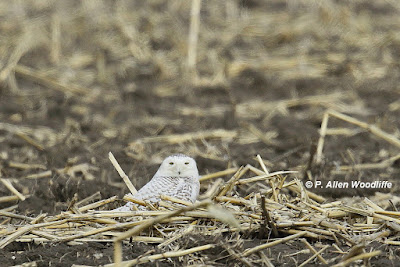Spring has been slow to take hold, although there have been a few days where it teased us somewhat. But that has been good for a lot of waterfowl diversity, and these last couple of weeks in March have been wonderful for catching great looks at so many species. Rondeau Bay has had thousands, possibly tens of thousands, of ducks, although in the last week or so the numbers have declined as they move on towards their nesting grounds. Mitchell's Bay and Lake St. Clair have experienced a similar onslaught of waterfowl.
 |
| Canvasback male |
 |
| Greater Scaup (rounded head) |
 |
| Lesser Scaup (taller head with more of a point) |
Ring-necked Ducks are one of my favourites, although for some reason I don't seem to be able to get the super close-up shots that I would like. There are a couple of Redhead mixed in with this group of Ring-necks.
Redheads, like scaup and Canvasback, can be present in huge numbers.
Snow Geese are not common here. In eastern Ontario and western Quebec there can be upwards of 100,000 Snow Geese present right now. An occasional Snow Goose, like this 'blue' phase one in the middle below, is a highlight in the southwest.
Sometimes in the flooded fields, a few gulls will congregate. In the flooded field just across the road fro McGeachy Pond, outside of Erieau, there has been both a Lesser Black-backed Gull...
.....and a Glaucous Gull, which also has been seen along the harbour and fish tug mooring area of Erieau itself.
Not technically a species of waterfowl, but a water bird, is this American Coot, which have been around for the last week or so and numbers are building.
The only 'shorebird' I've encountered so far is Killdeer, but I expect a few other species such as both yellowlegs, Dunlin and others to start to show any day now.
On the occasional warm day, a brave Eastern Painted Turtle has been seen out basking in the sunshine.
Great Blue Herons have arrived, and in the usual nest tree just east of Shrewsbury on Rondeau Bay a few have appeared. This nest tree has been collapsing for a few years now. This old willow was first used as a nest tree about 15 years ago. There are only 4-5 nests still there now, with most of the nesting birds having moved a little distance away in a clump of willows.
Another long-legged water bird is Sandhill Crane, which have been seen in proximity of large wetlands in both the Rondeau Bay area as well as Lake St. Clair.
Birds other than waterbirds are making their presence known. There has been a major influx of sparrows in the last few days, especially Song Sparrows. A reasonable search for birds at Rondeau will usually turn up anywhere from 50 to 125 of them without any trouble. They aren't all that cooperative for the camera, however.
Carolina Wrens are in full song on sunny days. Given the length and severity of the winter, I am surprised to see as many this spring as I do, since winters can be extremely hard on this year-round resident. I guess the abundance of spiders and such were enough to keep them alive.
Eastern Phoebes have arrived in the last few days, the first of several flycatcher species to show up in the spring.
The woodlands are fairly quiet so far. The Black Oak savanna habitat at Rondeau will be greening up soon, but hopefully, will attract a few Eastern Bluebirds and Red-headed Woodpeckers.
While the lake can be quite riled up in March, one of the windiest months of the year, it can also be quite placid. I enjoyed a walk along the South Point Trail of Rondeau on one of those placid days. I wonder how much longer this tree is going to be upright, given its proximity to the water's edge.
Since it often is still below freezing at night, and even some days, some ice remains where the wave action has splashed up, making for some interesting photos.
More reminders that winter hasn't left us altogether is the abundance of Snowy Owls still around. Just a few days ago while driving between Chatham and Mitchell's Bay, I counted no fewer than 12 Snowies!
Sometimes they pick the only patch of snow left on the ground.
When the snow is all gone, they may choose a cluster of corn stalks.
This one decided being inside a small chain link fence compound beside some gas pipes was the place to be. At first I thought it might not be able to get out, but after I got out of the car to investigate, it promptly got up and out with no trouble at all, and flew out into the corn field a few hundred metres away.
I left, but apparently it thought the fenced compound was the place to be, as when I came back 20 minutes later it had returned inside the fence!
And now on to what the month of April brings.....

























Pretty cool with that Snowy within the fenced area! I looked today, and it was not there!
ReplyDeleteIt is always interesting to see what attracts a Snowy as a place of reference to hang out at. First time for this kind of setting, at least in my experience.
DeleteVery impressive sea side snowy icicles. I can't even imagine that cold!
ReplyDeleteAnd this was during a relative warm period. I should send you a photo of the ice on the lake after a cold spell!
Delete